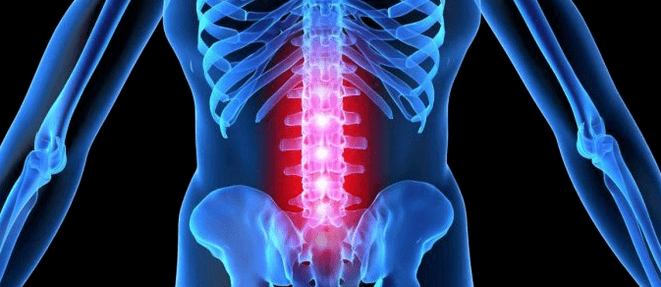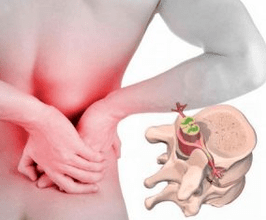Degenerative disease in which the body of the vertebra is destroyed and the intervertebral disc is called lumbar spinal osteochondrosis.The causes of such pathology can be varied, and to be treated properly, it is important to determine what actually affects the development of deformation at the bottom.If someone is concerned about the symptoms of osteochondrosis, you should contact the hospital immediately.
In stage 1, it is possible to cure problems with special medicines and training, but conservative methods do not always help at 2-3 degrees, so you need to use the surgical method.

The main reason
The left or right lumbar lumbar osteochondrosis is a degenerative properties in which the intervertebral disc is destroyed, fibrous rings and one have hernia that cause acute pain and functional function of the musculoskeletal system.The following factors can trigger osteochondrosis in the lower back:
- increased physical activity in the lower spine;
- incorrect body location while walking, sitting;
- Inactivity, inactive lifestyle;
- Posture is affected;
- injury, fracture or bruises causing degenerative in the spine;
- Congenital pathology The structure of the musculoskeletal system, in which the signs of deformation can be seen in children;
- obesity;
- Stress, lack of nutrients.
Stage and symptoms
Signs of lumbar osteochondrosis develop as the disease progresses, and the larger the stage, the stronger the symptoms are indicated.There are 4 degrees in total:
- In stage 1, the fibrous ring is damaged, the pain is not pronounced and often interrupts after walking.Pain is indicated by 2 species -lumbalgia, when symptoms are always disturbing, and lumbago, where signs occur suddenly.
- 2 -degree pop osteochondrosis is characterized by the large destruction of fibrous rings and disk displaced rings.Such a violation leads to a decrease in the space between the vertebrae and the nerve fiber.Level 2 progressive is accompanied by severe back pain, in the morning there are stiffness that has not passed for a long time.
- In 3 stages, the fibrous ring in the affected area was completely destroyed, which is why the hernia is formed, which compresses the vessels and roots of the spinal cord.The back hurts continuously, the symptoms do not retreat after the break and the reduction of the load, you feel the tingling and weight of the foot.In the third stage, muscle fiber distribution occurs, resulting in limited patient movement.
- In 4 stages, the spine is actually defective, one is worried about acute pain, as his motor activity is limited.Due to the supply of conservation and blood supply, swelling in the legs appears, the formation of bone grows between the vertebrae.At the latter, the risk of defect is high.
Lumbar spinal osteochondrosis syndrome
Lumbar osteochondrosis is indicated by the following syndrome:
- Sore.These are the main symptoms that characterize degenerative-dystrophic disorders in the spine.When the pathology lasts, the symptoms become significant, the attack can last for several days, negatively affecting human health.
- Korshka.Due to the depletion of the damaged disc body, the height of the intervertebral space decreases, in which the vertebra becomes unstable, irritating and reducing the nerves.One is worried about acute pain, nerve inflammation, blood supply.Muscle frames are atrophied, as lower extreme functions are interrupted.
- Ischemia.Progressive osteochondrosis in the lumbar region leads to the fact that blood vessels and arteries piercing the spine begin to compress.This disrupts the blood supply and nutrition of the internal organs and tissues, and also causes acute pain in the thighs, in the perineum.If the problem is not eliminated on time, paralysis or paresis is possible.
- Vertebrate.With the development of pain, ischemic and radicular syndrome, the patient's spine gradually defects, affecting the condition and well -being.The muscles become weak, the change in gait, the person tries to distribute the burden on the spine so that while moving to experience minimal discomfort.Such violations affect the work of the internal organs, while the intervertebral disc continues to change and damage more.

If the treatment of lumbar area osteochondrosis is inadequate or carried out on time, harmful complications may develop.In women, when the vertebrae in the L1 - S1 level, complications may occur during pregnancy, especially in the past, when the load on the spinal column is maximum.In men, the degenerative process in the lumbar region often causes problems with potential.Soon treatment threatens reactive spondylosis, as well as a high probability of developing osteoarthrosis of the knee, hip joint.Other consequences are also shown:
- compression ischemia;
- protrusion;
- Spondylarthrosis;
- Paresis.
Diagnostics
In order for the doctor to choose an effective treatment method, he or she needs to create an accurate diagnosis.Diagnosis begins at the office of a neuropathologist, who conducts an early examination, penetrates the affected area, assessing the nature of the spine change.During the acute period, the patient is unable to move and perform complex manipulation.For a more detailed study of spinal columns, instrumental diagnosis is set, which includes:
- X -ray.It is done in 3 projections, the picture shows the level of pathological development, the size of the intervertebral gap, the salt deposit, the vertebral structure.
- CT or MRI.Give a more detailed picture of the condition of the spine and the disc, show the violation of the soft tissue, which cannot be considered during the X -Ray examination.
How to treat the problem?
Medicine
The disease is characterized by the development of symptoms of pain that not all medications can be addressed.In the early stages to stop the signs, you can take painkillers.And the problem is also treated using special ointments and gels.In the case of advanced medications, the medication will be ineffective, so the doctor will prescribe the injection, thanks to the pain relief and timely aid.

Anti -steroidal drugs help to relieve swelling and inflammation, so that nerve fibers and blood vessels stop compress, and symptoms of pain decrease.This group includes funds:
- Painkillers.With the development of acute periods, when the pain is severely stated, the drug's medicine is prescribed.Because they have side effects, do not buy funds at your discretion.Safe and effective remedies should be prescribed by your doctor.
- Musorelaxants.Relieves muscle cramps, as pain and discomfort are reduced.
- Glucocorticosteroids.Eliminating inflammation, positively affects the nervous system, improves the patient's condition in a short time.
Training
If osteochondrosis L5 - S1 is diagnosed or disc at the L3 - S1 level, therapeutic training is required.When performing a training complex, it is important to gradually increase the load so that there is no discomfort and pain.It is recommended to perform the following exercises with osteochondrosis:
- In standing position, turn right and left, sting back and so on.
- Stand in all four, bend and coordinate the back.
- Lying on the floor, lifting the feet, without tearing the bottom from the floor.
- In a position to lie with the left hand, to the limbs, located to the right and, on the other hand.
Massage and physiotherapy
Chronic osteochondrosis in the remission stage was successfully treated using a massage procedure performed by a manual therapist.Massage will help normalize blood circulation in the affected area, creating nutrition.Physiotherapy procedures have the same effect:
- electrophoresis;
- magnetot therapy;
- laser therapy;
- Uhf.
If a patient with left or right osteochondrosis does not help with the conservative method, then you cannot do without surgical treatment.Microdisctomy is often used, where isolated hernia is removed using a microsurgical device.The minime psidium procedure, the next day after surgery, the patient may begin to move.
Prevention
Because adults and children suffer from osteochondrosis, it is important even from an early age to monitor the spine, control posture, pay attention to how bending or movement looks like.If there is a suspicion of deformation, you should see a doctor.The sooner the disease is diagnosed, the easier it is to fight it later.





































